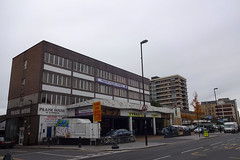As noted in an earlier article, I’m covering the site of 145–151 London Road in a mini-series of four articles. The first of these covered the initial development of the site and the full history of the southernmost property built there, the second discussed the second property going northwards, the present article covers the third property, and the fourth will discuss the fourth property plus the present-day occupants of the entire site.
1840s–1850s: Charles Moss and William Pugh
The house was built between 1844 and 1849, as the northernmost of a block of three, and like its neighbour to the south saw a fair bit of turnover in the years following its construction. By 1849 it was occupied by metal merchant Charles Moss and his wife, Kate,[2] but in 1854 Charles and Kate were replaced by William Pugh, who in turn remained only until the end of the decade.[3]
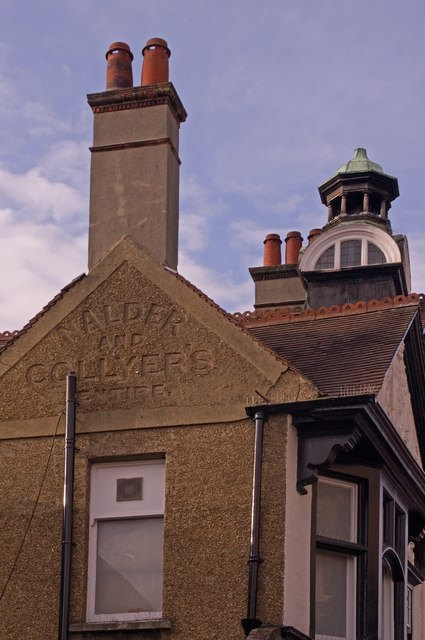
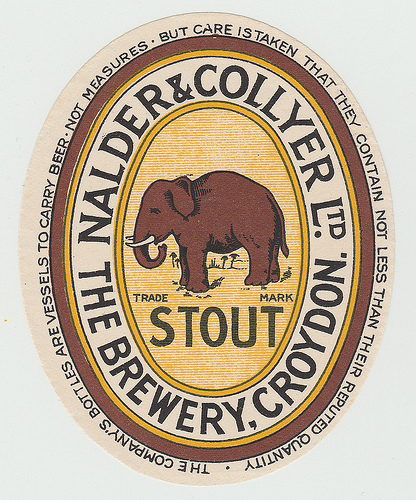
1860s: Bristow Collyer
Next to arrive was a 30-something brewer named Bristow Collyer, who for the previous decade had been brewing in partnership with Francis and Howard Nalder under the name Nalder & Collyer. Bristow was well-placed to work as a brewer, being descended not only from a Farnham innkeeper (his grandfather) but also from the Bristows of Beddington, a long-established family of hop marketers.[5]
His brewery was also long-established, having been originally opened in 1586 and passed through several sets of hands before Francis, Howard, and Bristow signed the lease on 29 September 1849. As well as the brewery itself, which was situated on Croydon High Street, this lease included 27 pubs; two of these, the Bricklayers Arms on the High Street and the Blue Anchor on South End, are still trading today, albeit under different names and not in the original buildings.[6]
Bristow and his family moved to London Road by September 1860, and remained until at least the mid-1860s; they may then have moved elsewhere in Croydon, and possibly even to Beddington by the end of the decade, but the evidence on this is unclear.[7] In any case, Bristow himself died after a sudden illness at the age of only 42, on 12 July 1870, and was buried in Beddington Churchyard.[8]
The brewery remained in the hands of the Nalder family until 1919, when Nalder & Collyer’s Brewery Co Ltd was sold to the City of London Brewery in a deal which included 170 pubs as well as the brewery.[9] The latter company continued to brew under the Nalder & Collyer name at the Croydon site until at least 1936. The brewery closed down some time after that, and was finally demolished in 1964. Today, the site is occupied by an office and retail block, Leon House.[10]
1860s–1870s: George Browne and Reverend Turner
By 1869, Bristow’s old London Road house was occupied by George and Caroline Browne. Like William Ashmead Tate a few doors to the south, George had been employed by the East India Company, though in the somewhat less physically-demanding role of assistant auditor. He died shortly after moving to London Road, on 1 February 1870, at the age of 80. Caroline remained in the house for a short while, but had departed by 1874. Her replacement was Reverend T H Turner, about whom little information survives and who in any case was gone by 1876.[11]
1870s–1880s: London Road High School For Girls
In something of a departure from the previous use of all three houses, the mid-1870s saw the transformation of this northernmost one into a private school known as London Road High School For Girls. Run by a Miss Pearse, it taught subjects including “English language, geography, book-keeping, French, Scripture, and drawing (model and free-hand)”. It housed around half a dozen boarders, and students came from as far away as Reading.[12]
1880s: Charles William Alexander
Miss Pearse’s school remained here until around 1882, and then departed. A couple of years later the house was re-occupied by yet another family with an Indian connection: “East India Merchant” Charles William Alexander, his wife Ellen, and half a dozen children. They in turn only remained a handful of years, and had moved to Wandsworth by 1891.[13]
1890s–1900s: Rosa and Clarence Paget
By 1890, the house was occupied by Rosa Paget, a widow in her mid-50s whose household also included her adult daughters Mary and Florence and her teenage son Clarence.[14]
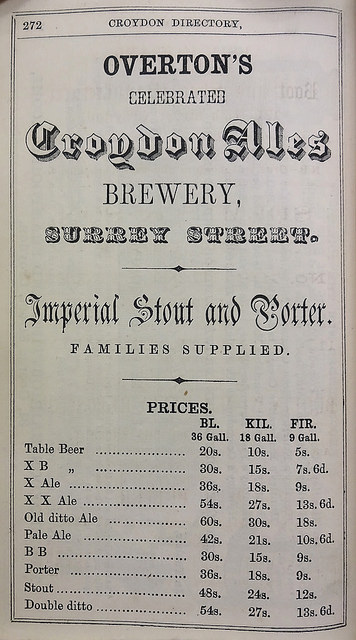
Born in Croydon in 1835, Rosa was the youngest daughter of Henry Overton, a successful brewer who also owned several properties and areas of land in and around Croydon. A couple of years after Rosa’s birth, Henry bought a plot of land on London Road and built three houses on it: 145, 147, and 149 London Road.[15]
Rosa’s mother Mary died when Rosa herself was just eight years old, but Henry survived until 11 January 1864, when he died at home on Surrey Street, aged 74.[16]
Henry’s will divided his property among his children and sons-in-law. The brewery, malthouse, and various beerhouses went to his son Frederick, while Rosa was left several other beerhouses, cottages, tenements, and residential houses — including 149 London Road, occupied at that point by Bristow Collyer.[17]
A year after her father’s death, Rosa married Richard Paget at Croydon Parish Church (now Croydon Minster). Richard, an auctioneer living and working in Guildford, brought his new bride back to Guildford and installed her in Belmont House, the “imposing buildings and grounds” of which must have been quite a change from her previous home on Surrey Street.[18] Over the 14 years of her marriage, Rosa gave birth to eight children, only four of whom survived; and in December 1879 she also lost her husband Richard, who died at home at the age of only 43.[19]
Rosa continued to live in Guildford for some time after her husband’s death, but by 1890 she had returned to Croydon, taking up residence at 149 London Road along with Mary, Florence, and Clarence. She gave her new home the name of Guildford House, reflecting the years she spent living in that town.[20] Around 1901 she moved to a newly-built house at 47 Chatsworth Road, which she again named Guildford House, and remained here until her death on 31 October 1927 at the age of 92.[21]
Rosa’s return to Croydon proved to be quite a boon for the town itself. Her son, Clarence, continued to live on Chatsworth Road after her death, and became one of Croydon’s most respected local historians. Working from primary sources, he published two books, Byways in the History of Croydon and Croydon Homes of the Past, and his transcriptions of original documents including indentures, deed polls, the Ancient Muniments of the Whitgift Foundation, and the 15th/16th century Manor of Croydon Terriers can still be consulted at the Museum of Croydon today. He died at Worthing on 26 September 1952.[22]
1900s: William Wilson
Rosa and Clarence’s move to Chatsworth Road left 149 London Road vacant, but it was soon reoccupied by William Wilson, who gave it the name of Ardbeg. He only remained for a handful of years, though, and was gone by 1907.[23]
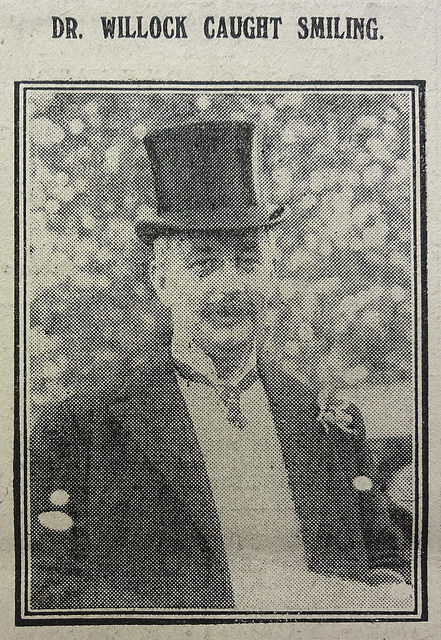
1900s–1910s: Edward Hulse Willock
William’s replacement was Edward Hulse Willock, a surgeon in his late 30s. Edward first arrived on London Road in the mid-1890s, taking a house a little to the south of the junction with Sumner Road. He moved further south to number 149 around 1906, and remained here until around 1920.[24]
Edward served as surgeon at the Croydon War Hospital, assistant surgeon at Croydon General Hospital, and medical referee for the Ministry of Pensions. He was also active in the British Medical Association, being honorary secretary of its Croydon Division and later a member of its Central Council. He became a Justice of the Peace in 1912.[25]
After retiring to Exeter in the early 1920s, he became chair of the Exeter National Service Medical Board and president of the Devon Archaeological Exploration Society. Considered “an authority on the Stone Age, with a special knowledge of flint instruments”, he discovered a Neolithic settlement on the Haldon Hills in Devon including the remains of huts, flint instruments, and a piece of pottery which ended up in the British Museum.[26]
1920s–1930s: Albert W A Davies
Following Edward’s departure, his London Road practice was taken over by another surgeon. Albert W A Davies was in place by 1921, and remained for around two decades, but was likely gone again by 1941.[27]
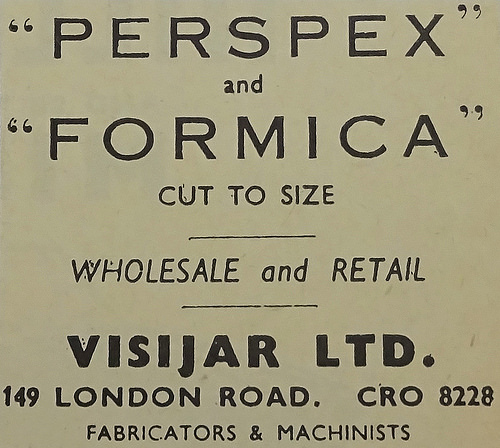
1950s–1960s: Visijar Ltd
It’s unclear what the property was used for during the decade after Albert left. However, on 27 September 1949, R V Rosevear of 587 London Road was granted planning permission for “The use of No. 149 London Road, West Croydon, for the manufacture of perspex laboratory equipment and fittings”. By January 1950, the manufacturing company — Visijar — was in place.[28]
Founded in the late 1940s, Visijar began its manufacturing activities by producing the eponymous “Visijar”, a clear acrylic museum specimen display “jar” intended to replace the glass jars in use at the time. As noted above, by the time of its move to number 149 it had already begun to expand into laboratory equipment. Later products included the intriguingly-named “‘Visijar’ walking machine”, passenger windows for Dakota planes, a ten-foot-tall model of the human nervous system for the 1951 Festival of Britain, and a mounting system for the Dead Sea Scrolls.[29]
Visijar continued to manufacture at 149 London Road until November 1965, when it moved to Pegasus Road on the old Croydon Airport site.[30]
Late 1960s: Demolition
Visijar was likely the last ever occupant of 149 London Road. Even before its move to Croydon Airport, planning permission had been granted to replace numbers 145–149 with a new “motor showroom, workshop, office accommodation and [...a re-sited] petrol filling station”.[31]
Work was to take place in stages, and the full timeline is unclear.[32] However, by late 1969 the three houses built by Henry Overton more than a century before had been demolished, and the site completely redeveloped. The full story of the four-floor garage and office block that stands there today will be told in my next article, which forms the concluding part of this mini-series.
Thanks to: Carole Roberts; Christine Morgan, churchwarden at St Mary’s, Beddington; Peter Dickinson of the Labologist’s Society; the Planning Technical Support Team at Croydon Council; the staff, volunteers, and patrons at the Museum of Croydon; and my beta-reader Steve. Census data and London phone books consulted via Ancestry.co.uk. Monetary conversions performed using the Bank of England inflation calculator (prices < £100 given to the nearest penny, prices from £100 to < £100,000 to the nearest pound, prices from £100,000 to < £1 million to the nearest £1,000, prices from £1 million to < £100 million to the nearest £100,000, prices ≥ £100 million to the nearest million).
Footnotes and references
- The names on the houses appear to read, from south to north: Lambert, Brown, and Paget. “Paget” likely refers to Rosa Paget, whose father Henry Overton left her the northernmost house on his death in 1864, and who lived in the house herself from around 1889 to around 1901 (see later in the present article). I’ve found no evidence of a Lambert living in any of the three houses, nor of a Brown living in the middle house, though there was a Robert Charles Brown living in the southernmost house from around 1903 to around 1907.
- See an earlier article for evidence on the date of construction. As noted there, the July 1849 Lighting Rate Book lists “S Jackson” and “Moss” on this part of London Road. The 1851 census gives Moss’s first name and profession, and the name of his wife. Charles and Kate are aged 56 and 44 respectively at the time of this census, and are almost certainly the Charles and Kate Moss living in Little Ilford at the time of the 1841 census, both of which pieces of evidence suggest that they were already married when Charles arrived on London Road.
- Charles Moss is listed in Gray’s 1851 and 1853 directories as well as the 1851 census. The Museum of Croydon’s Marshall Liddle & Downey collection includes a deed dated 23 August 1854 (index page 19–20) in which William Pugh of Carshalton leases the house and land from Henry Overton for a period of 7 years from 29 September 1854 at a rent of £100/year (£10,000/year in 2015 prices). The deed is marked in the index as “cancelled”, which fits with the fact that William was gone by late 1860; William is listed in Gray & Warren’s 1855 and 1859 directories, while the November 1860 Poor Rate Book instead lists B Collyer.
- “Entire” was a mixture made from several different types of beer. For more information, see “Fredrick Accum” by Ron Pattinson, 18 October 2007.
- As noted in the previous footnote, Bristow Collyer (as “B Collyer”) is listed in the November 1860 Poor Rate Book. His full name, age, and profession are taken from the 1861 census. Information about his ancestors and business partners is taken from page 5 of Herbert Shaw, “A Croydon Brewery”, Brewery History vol. 131 pp. 2–18 (PDF), which itself is a reprint of an article originally published in Proceedings of the Croydon Natural History and Scientific Society vol. 17(10) pp. 249–262.
- “A Croydon Brewery”, pp. 2, 5, 15, 16. According to High Street historian Carole Roberts, the Bricklayers Arms was demolished around 1929, and a new pub building constructed on its site (via email, 4 October 2019). It was later known as the Catherine Wheel and is currently the Crown & Pepper. An old Nalder & Collyer boundary plate can still be seen just to the south of the main building today. According to pub historian Ewan Munro, the Blue Anchor was also rebuilt in the 1930s. It’s currently called the Tree House. The other pubs listed in “A Croydon Brewery” as still being trading at the time of its original publication were the Half Moon at Broad Green, which has been demolished and replaced with flats, and the Duke’s Head on South End, which is now a restaurant called Apatura.
- The Museum of Croydon’s Marshall Liddle & Downey index summary of a deed dated 10 September 1860 (index page 19) states that as of that date the house was “formerly in occ. of Charles Moss and now Bristow Collyer” (the deed actually relates to the house to the south of this one, so provides just a snapshot of occupancy rather than an exact date for the start of Bristow’s lease). Bristow is listed in the November 1860 Poor Rate Book, the 1861 census, Gray & Warren’s 1861–62 directory, Simpson’s 1864 directory, and Warren’s 1865–66 directory. The June 1866 Poor Rate Book possibly instead lists “Brown”, but the writing is unclear and in any case these books sometimes listed people out of order. Warren’s 1869 directory lists George Browne at Bristow’s old house, and George’s entry in the National Probate Calendar states that he died at that house on 1 February 1870 — that is, five months before Bristow himself died, and so Bristow must have moved away from London Road before his death. A death announcement for Bristow’s 9-month-old son Bruce in the 22 May 1868 Morning Post states that the death occurred “at Croydon”, but does not specify London Road, so Bristow may remained on London Road until that date or may have moved elsewhere in Croydon when he left London Road (viewed online at the British Newspaper Archive; requires subscription).
“A Croydon Brewery” states that Bristow had a house, “Riversdale”, at Beddington at the time of his illness, and that this house is where he died. However, Bristow’s entry in the National Probate Calendar describes him as being “late of Croydon in the County of Surrey”, and this is the wording usually used in this source for a person’s place of residence at their time of death — if they’d moved house shortly before dying, their previous address is given with the wording “formerly of”. Moreover, Warren’s 1869 directory lists “Collyer-Bristow, esq.” at “Riverside” in Beddington; presumably a relative of Bristow’s.
Bristow’s age at death, date of death, and place of burial are taken from Croydon In The Past, a book published by Jesse Ward in 1883 giving transcriptions of headstones in Croydon’s various burial grounds (I have also confirmed this myself by visiting his grave; see photo of wording on headstone). “A Croydon Brewery” gives the additional information that he was buried “in one of the family graves”, though from my own observations the only other people listed on his headstone are his sons Bruce and Bristow and his daughter Marion. (“A Croydon Brewery” states that he died on 11 July, but this must be a mistake, as his National Probate Calendar entry also says 12 July.)
- “A Croydon Brewery”, p. 8; and Richmond & Turton (1990) The Brewing Industry: A Guide to Historical Records, p. 245.
- “A Croydon Brewery”, pp. 13 and 14. That article states that the Croydon brewery closed down in 1936, but no source is given for this information. Moreover, it seems to be contradicted by an article on the front page of the 18 April 1936 Croydon Times which describes the sell-off of most of Nalder & Collyer’s pubs to Ind Coope & Allsopp, but states that “It is understood that Nalder and Collyer will continue brewing for the 31 houses [i.e. pubs] they have retained, but their activities, of course, will be on a smaller scale.” The Brewing Industry: A Guide to Historical Records simply states that the company “continued to brew until 1936, changing its name to Nalder’s Brewery & Investment Trust Ltd in 1941 and going into liquidation in 1960.”
- George Browne is listed in Warren’s 1869 directory. His date and place of death are taken from his entry in the National Probate Calendar, and his age at death is taken from his death announcement on page 4 of the 3 February 1870 Evening Standard (viewed online at the British Newspaper Archive; requires subscription). His profession is taken from the 1851 census, at which point he and Caroline were living on Clifton Road in Brighton. The abovementioned death announcement also confirms that he was “late of East India House” (headquarters of the East India Company). The 1871 census lists Caroline still at the house, now a widow, but the address is absent from Wilkins’ 1872–3 directory (suggesting it was vacant) and Ward’s 1874 directory lists Reverend T H Turner. I haven’t been able to find out when or where Caroline died; it may well have been on London Road.
- London Road High School For Girls is listed in Ward’s directories from 1876 to 1882 inclusive. All entries include the name of Miss Pearse. Quotation regarding subjects is taken from an announcement on page 5 of the 23 February 1878 Berkshire Chronicle (reproduced here), which states that Florence E Macaulay of Reading had recently passed the College of Preceptors examination in all six subjects and obtained a “special certificate for French”. The 1881 census lists seven “scholar”s at the premises, aged from 9 to 19, as well as two servants, two English teachers, a French teacher, and a music teacher. Miss Pearse is nowhere to be seen; one of the English teachers, 32-year-old Mary Ann Matthews, is listed as the head of the household.
- Ward’s directories list London Road High School For Girls up to and including 1882, “Unoccupied” in 1884 and 1885, Charles William Alexander from 1886 to 1889 inclusive, and Mrs Paget from 1890 onwards. They also list Charles at 130 St James’s Road up to and including 1885. Other information is taken from the 1881 and 1891 censuses, in which Charles appears at 130 St James’s Road, Croydon, and 27 Dalebury Road, Wandsworth, respectively. The 1891 census lists nine children, with the eldest three born in Selhurst, the next five born in Croydon and aged 2 upwards, and the youngest born in Brighton and aged just 10 months. I have no evidence regarding where Charles and Ellen were living in 1890, hence my conservative assertion that they’d moved to Wandsworth by 1891; they’d definitely left London Road by 1890 though.
Ward’s directories list “Mrs Paget” at 91 London Road (later renumbered to 149) from 1890 to 1901 inclusive. The 1881 census lists Rosa (as “Rose”) as a 45-year-old widow and “Annuitant” at Belmont House, Epsom Road, Guildford. Mary, Florence, and Clarence are 14, 10, and 7 years old respectively in that census, and all born in Guildford; their 8-year-old brother Richard is also present. The 1891 census has Rosa, Mary, Florence, and Clarence at a boarding house in Hastings, while the 1901 census shows Rosa, Florence, and Clarence back at 91 London Road. The siblings mentioned are all single at these points, strengthening my assertion that they were part of their mother’s household. (As noted in a later footnote, Mary got married in August 1891.)
Regarding the 1891 census placing of the family in Hastings, they were almost certainly on holiday. As noted above, Ward’s directories list them on London Road during this time, and the address of the boarding house is on White Rock, which according to OpenStreetMap is right on the edge of the beach, near Hastings Pier. The census shows that the London Road house is occupied by a housemaid, Ellen Gough, and a cook, Mary Ann Tyler, presumably left in charge while the family was away.
According to a biographical slip at the Museum of Croydon, Rosa Overton was born on 7 May 1835; the reference for this information is “ML&D 210 13/4/1866”, which refers to an item in the Marshall Liddle and Downey boxes that I haven’t yet looked at myself. The year is in agreement with census data and her year of death and age at death (see later footnote), though. The 1861 census shows Henry Overton, 71-year-old brewer and widower, along with his 25-year-old daughter Rosa at 17 Surrey Street. The fact that she was his youngest daughter is taken from her marriage announcement in the Surrey Advertiser (see later footnote).
See my article on 145 London Road for more on Henry Overton’s purchase of the London Road land and construction of houses thereon. According to the Museum of Croydon’s Marshall Liddle & Downey index summary of a deed dated 1 March 1858 (index page 49), at some point these three houses were known as 1–3 Montague Place; however, I haven’t managed to find this naming in contemporary street directories. They appear in Gray’s 1851 directory as 46, 47, and 48 London Road, and were renumbered to 87, 89, and 91 London Road around 1890 and again to 145, 147, and 149 London Road around 1927.
- According to the Museum of Croydon’s Marshall Liddle & Downey index summary of a deed dated 11 October 1848 (index page 13), Henry’s wife Mary died on 5 March 1844. Date and place of Henry’s death are taken from his entry in the National Probate Calendar, and his age at death is taken from a death announcement on page 8 of the 13 January 1864 Morning Post (viewed online at the British Newspaper Archive; requires subscription).
- Information on Henry’s will taken from a copy held in the Museum of Croydon’s Marshall Liddle & Downey collection (box corresponding to index pages 22–28; will dated 20 October 1863, index page 22–23). As well as 149 London Road (specified in the will as number 48, which was later renumbered to 91 and then 149), Rosa’s inheritance included “all that Freehold public house stabling garden & premises situate at Elms [sic] End in the Parish of Beckenham in the County of Kent called ‘The William the 4th’ & let on lease to Mr. Hollyfield at £60 per annum. And also all that piece of freehold land containing about 3 acres situate at Elms [sic] End aforesaid & adjoining to the garden of the last mentioned premises & in the occupation of the said Mr Hollyfield. And also all those eight small freehold tenements with gardens situate at Elms [sic] End aforesaid & contiguous to the aforesaid Public House called ‘The William the 4th’ & now or late respectively occupied by Messrs Russell, Sewell, Hollidge, ?Bollas?, Portsmouth, White, Levens and Hollidge as Tenants. And also all that freehold Cottage & premises in Union St Croydon aforesaid in the tenure or occupation of Mr Smith. And also all that freehold house situate in the old Town Croydon in the occupation of Messrs Matthews & Roffey. And also all that freehold Beerhouse land & premises situate at West Wickham in the County of Kent let to Mr. Walters as yearly tenant. And all those 4 small freehold tenements adjoining to the lastly described premises & situate at West Wickham aforesaid respectively occupied by Messrs Grant, Collins, Savage & Newman. And also all that freehold house & garden situate at South End Croydon aforesaid let on lease to Mr. Bailey. And also all that Freehold Beerhouse situate at Shirley in the parish of Croydon aforesaid with garden & premises attached thereto let to Mr Leach. And also all those two freehold cottages & gardens situate at Shirley aforesaid adjoining the lastly described premises & let respectively to Messrs Pusey and Antrim. And also all that freehold Beerhouse called ‘The Bird in the Hand’ situate on Croydon Common in the said parish of Croydon with the large garden belonging to same late in the occupation of Mr Gainsford but now of Mr. Price as a yearly tenant thereof. And also all that piece of freehold land situate on Croydon Common aforesaid adjoining to the lastly described premises and in the tenure or occupation of Mr. Etherington as yearly tenant thereof but who is now under notice to quit. And also all those four small freehold tenements with the gardens thereto situate on Croydon Common aforesaid in the respective occupations of Mr Rhodes, Mr. Shepherd, Mr Thornton & Mrs. Gower. And also all those Copyhold premises held of the Manor of Chelsham & situate at Chelsham in the said County of Surrey being ‘The Hare and Hounds’ Beerhouse & premises let to Mr Baker as a yearly tenant and All those 5 small Copyhold tenements immediately adjoining to the said last mentioned beerhouse and premises & held of the same manor & let respectively to Messrs Richardson, Whitman, Cox, Golding and Comford. And also all those 200 Shares part of 1000 Shares of £5 each fully paid up which I hold in the Croydon Gas Company.”
- A marriage announcement on page 3 of the 18 February 1865 Surrey Advertiser states that “On the 9th inst., at the parish church, Croydon, Mr. Richard Paget, of Guildford” married “Rosa, youngest daughter of the late Henry Overton, Esq., of Croydon” (viewed online at the British Newspaper Archive; requires subscription). It’s not clear whether Rosa and Richard moved into Belmont House immediately after their marriage, but they were certainly there by August 1866, as a birth announcement on page 8 of the 25 August 1866 Newcastle Guardian and Tyne Mercury records: “GUILDFORD.—At Belmont House, on the 15th inst., the wife of Mr Richard Paget, of a daughter.” (viewed online at the British Newspaper Archive; requires subscription). Quotation describing Belmont House is taken from Guildford Through Time by Bernard Parke and David Rose, which also gives its location as being on the Upper High Street near the junction with Epsom Road, and states that it was “demolished during the 1930s and replaced by the Prudential Buildings”. Richard’s profession is taken from a list of agents of the London Assurance Co in an advertisement on the front page of the 26 March 1867 Sussex Express (viewed online via the British Newspaper Archive; requires subscription). The 1871 census lists Rosa and Richard at Belmont House, Epsom Road, Guildford, with two daughters; at this point, Richard is 33 years old to Rosa’s 35, and his profession is given as land surveyor.
- Numbers of Rosa’s children are taken from the 1911 census, which asks married women to fill in the number of children born to the present marriage, the number still living, and the number who have died. Rosa appears to have misunderstood the instructions and filled these columns in despite her widowhood; the figures have later been crossed out red ink, but are still legible. Richard’s date and place of death, along with his age at the time, are taken from a death announcement on page 4 of the 20 December 1879 Croydon Advertiser (viewed online at the British Newspaper Archive; requires subscription).
- Ward’s directories list Mrs Paget at 91 London Road (later renumbered to 149) from 1890 to 1901 inclusive. Although these directories don’t use the name “Guildford House” until the 1893 edition, an announcement of Rosa’s daughter Mary’s wedding on page 4 of the 29 August 1891 Sussex Agricultural Express describes the bride as “elder daughter of the late Richard Paget, Esq., of Guildford, and of Mrs. Paget, of Guildford House, Croydon”. See earlier footnote for evidence of Mary, Florence, and Clarence remaining part of her household
Ward’s directories list Mrs Paget, Guildford House, at 47 Chatsworth Road in 1902 to 1913 inclusive, and at 39 Chatsworth Road from 1914 to 1928 inclusive, though the positioning of sideroads shows that this change was just a renumbering of the houses; Rosa’s house is the first one to the north of the junction with Beech House Road throughout. She is also listed at 47 Chatsworth Road in the 1901 edition, though without the Guildford House name; presumably her move took place during the period of data collection. Prior to 1901, the housing on the road stops short before reaching Beech House Road, as can also be seen on the 1896 Ordnance Survey map of the area.
Rosa’s date of death is taken from her entry in the National Probate Calendar, which also gives her address at the time as “Guildford House Chatsworth-road Croydon” and lists Richard Paget and Clarence George Paget as her executors. Her age at death is taken from the England & Wales, Civil Registration Death Index, 1916-2007 via Ancestry.co.uk.
- Ward’s directories list C G Paget at 39 Chatsworth Road from 1929 to 1939 (the final edition of these directories) inclusive. He also appears there in London phone books up to and including the October 1948 edition. Other information is taken from his obituary in the 4 October 1952 Croydon Times (viewed as a photocopied clipping in his biographical file at the Museum of Croydon), as well as personal knowledge — I’ve used his transcriptions myself, most notably in my article on Croydon General Hospital.
- Ward’s directories list William Wilson, Ardbeg, from 1902 to 1906 inclusive.
- Ward’s directories list Edward at 113 London Road (later renumbered to 193) from 1895 to 1906 inclusive, and at 91 London Road (later renumbered to 149) from 1907 to 1920 inclusive. The site of the former house can be seen in the first of the articles in this mini-series, under the section on the Goodinges and the Finns; it is two houses to the southeast of the one marked X on the second 1868 Town Plans excerpt. Edward’s age is given as 33 in the 1901 census, making him around 38 in 1906.
- Edward first appears in the Ward’s directories list of Borough Justices in the 1913 edition, indicating an appointment during 1912. Other information taken from his obituary on page 695 of the 27 November 1943 British Medical Journal and confirmed via the Medical Directory entry reproduced here.
Information taken from Edward’s British Medical Journal obituary (see earlier footnote) and another obituary on page 4 of the 15 October 1943 Exeter and Plymouth Gazette (viewed online via the British Newspaper Archive; requires subscription); the quotation is from the latter source.
It’s unclear exactly when Edward moved to Exeter. Ward’s directories list him at 91 London Road (later renumbered to 149) up to and including the 1920 edition, and he is absent from the alphabetical lists of residents and professionals/tradesmen thereafter; moreover, A W Davies is listed at 91 London Road in his place from 1921 onwards. However, the Medical Directory lists Edward at 91 London Road up to and including the 1924 edition, and at Velwell Road, Exeter, only from 1925 onwards (the 1925 edition puts him at 69 Velwell Road while later editions have 68 Velwell Road; the former address seems to be a mistake, as according to Besleys Exeter Directory there were no odd numbers on Velwell Road at this time). Besleys Exeter Directory lists him at 68 Velwell Road in 1924 and 1925; in 1923 he is absent from the alphabetical listings, and 68 Velwell Road is occupied by Rev G F Owen, baptist minister (I haven’t checked beyond 1925). He may have briefly lived somewhere else in between Croydon and Exeter, or perhaps he spent some time staying with a friend before finding a home in Exeter.
- Ward’s directories list A W Davies, MRCS, LRCP, at 149 London Road (numbered as 91 in 1921–1926) from 1921 to 1939 inclusive; 1939 was the final edition of these directories. He also appears in London phone books (as A W A Davies) up to and including 1940, but I haven’t been able to find him in later editions. These phone books also give the additional address of Verecroft, Sanderstead Road. His full first name is taken from his entry in the 1939 Medical Directory, which also gives his qualification date as 1916. The Medical Directory lists him on Sanderstead Road up to and including the 1941 edition, and at “Address unknown” thereafter.
- Planning application viewed on microfiche at Croydon Council offices (ref 49/902). This permission was to expire on 27 September 1959, as “The site is in an area which is proposed to be re-planned as a whole” — it was later extended to 27 September 1975, though again limited in time as “the site is not in an area reserved for industrial purposes in the Croydon Development Plan” (ref 54/1002; R V Rosevear was again the applicant in this case). London phone books list “The Visijar Laboratory Supplies Co Ltd, Laboratory Frnshrs [Furnishers]” at 149 London Road from the January 1950 edition onwards.
- According to an advertisement in the 14 February 1969 Croydon Advertiser Centenary Supplement (viewed as a clipping from the firms files at the Museum of Croydon), the company had been in existence for 21 years at that point, i.e. since 1948. The “walking machine” is mentioned in the printed heading of a note forming part of a planning application for a new sign at the premises (ref A371); sadly I’ve not been able to find out anything more about this! Information on other products and date of move to Pegasus Road taken from the abovementioned 1969 advert.
- Date and place of move taken from the aforementioned advert in the 14 February 1969 Croydon Advertiser Centenary Supplement. According to another advert clipping in the Museum of Croydon firms files, annotated “1974”, the company was still on Pegasus (mis-spelled as “Pagasus”) Road in 1974.
- Ref 64/285, granted on 20 April 1964.
- The abovementioned application (ref 64/285) lists four phases in total, the third of which was “New motor showrooms and offices”.

